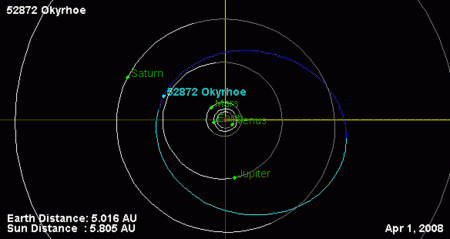52872 Okyrhoe
52872 Okyrhoe /oʊˈkɪroʊ.iː/ is a centaur orbiting in the outer Solar System between Jupiter and Saturn. It was discovered on 19 September 1998, by the Spacewatch survey at Kitt Peak Observatory in Arizona, United States, and named after Ocyrhoe from Greek mythology.
| Discovery | |
|---|---|
| Discovered by | Spacewatch |
| Discovery site | Kitt Peak Obs. |
| Discovery date | 19 September 1998 |
| Designations | |
| (52872) Okyrhoe | |
| Pronunciation | /oʊˈkɪroʊ.iː/[1] |
Named after | Ωκυρόη, Ωκυρρόη Ōkyroē, Ōkyrroē |
| 1998 SG35 | |
| centaur[2][3][4] | |
| Orbital characteristics[2] | |
| Epoch 13 January 2016 (JD 2457400.5) | |
| Uncertainty parameter 0 | |
| Observation arc | 5393 days (14.77 yr) |
| Aphelion | 10.908 AU (1.6318 Tm) |
| Perihelion | 5.7875 AU (865.80 Gm) |
| 8.3478 AU (1.24881 Tm) | |
| Eccentricity | 0.30670 |
| 24.12 yr (8809.66 d) | |
| 118.92° | |
| 0° 2m 27.11s / day | |
| Inclination | 15.665° |
| 173.03° | |
| 337.79° | |
| Earth MOID | 4.80423 AU (718.703 Gm) |
| Jupiter MOID | 0.468729 AU (70.1209 Gm) |
| TJupiter | 2.945 |
| Physical characteristics | |
| Dimensions | 49 km[5] |
| 8.3 h[6] | |
| 0.03[7] | |
| B–V = 0.743±0.065[8] V–R = 0.495±0.042[8] | |
| 10.8[2] | |
Orbit
Centaurs have short dynamical lives due to strong interactions with the giant planets. Okyrhoe is estimated to have an orbital half-life of about 670 kiloannum.[9]
Of objects listed as a centaur by the Minor Planet Center (MPC),[4] JPL,[2] and the Deep Ecliptic Survey (DES),[3] Okyrhoe has the second smallest perihelion distance of a numbered centaur. Numbered centaur (315898) 2008 QD4 has a smaller perihelion distance.

Sublimation
Okyrhoe passed perihelion in early 2008,[2] and exhibited significant magnitude variations during March and April 2008.[10] This could be a sign of sublimation of volatiles.
Name
It was named after Ocyrhoe, the daughter of Chiron and Chariclo from Greek mythology.
References
- 'Ocyroe' in Noah Webster (1884) A Practical Dictionary of the English Language
- "JPL Small-Body Database Browser: 52872 Okyrhoe (1998 SG35)" (last observation: 2008-06-06). Retrieved 12 April 2016.
- Marc W. Buie. "Orbit Fit and Astrometric record for 52872" (last observation: 2008-04-24). SwRI (Space Science Department). Retrieved 2008-10-11.
- "List Of Centaurs and Scattered-Disk Objects". Minor Planet Center. Retrieved 2008-10-16.
- Wm. Robert Johnston (22 August 2008). "List of Known Trans-Neptunian Objects". Johnston's Archive. Retrieved 2012-05-10.
- Bauer, J. M.; Meech, K. J.; Fernandez, Y. R.; Pittichova, J.; Hainaut, O. R.; Boehnhardt, H.; Delsanti, A. C. (2003). "Physical Survey of 24 Centaurs with Visible Photometry". Icarus. 166 (1): 195–211. Bibcode:2003Icar..166..195B. doi:10.1016/j.icarus.2003.07.004.
- E. Dotto; M.A. Barucci; C. de Bergh. "Colours and composition of the Centaurs". Osservatorio Astronomico di Roma, Italy. Retrieved 2008-10-19. (word format)
- Hainaut, O. R.; Boehnhardt, H.; Protopapa, S. (October 2012). "Colours of minor bodies in the outer solar system. II. A statistical analysis revisited". Astronomy and Astrophysics. 546: 20. arXiv:1209.1896. Bibcode:2012A&A...546A.115H. doi:10.1051/0004-6361/201219566. Retrieved 26 September 2019.
- Horner, J.; Evans, N.W.; Bailey, M. E. (2004). "Simulations of the Population of Centaurs I: The Bulk Statistics". Monthly Notices of the Royal Astronomical Society. 354 (3): 798. arXiv:astro-ph/0407400. Bibcode:2004MNRAS.354..798H. doi:10.1111/j.1365-2966.2004.08240.x.
- Trigo-Rodríguez; Melendo; García-Hernández; Davidsson; Sánchez; Rodríguez (2008). "A continuous follow-up of Centaurs, and dormant comets: looking for cometary activity" (PDF). European Planetary Science Congress. Retrieved 2008-10-12.